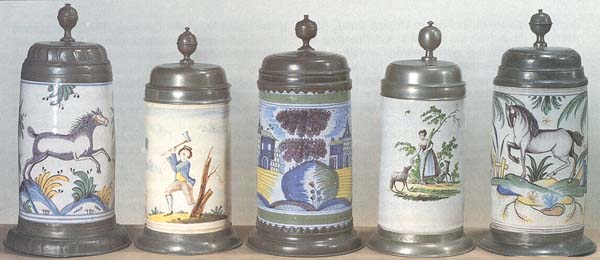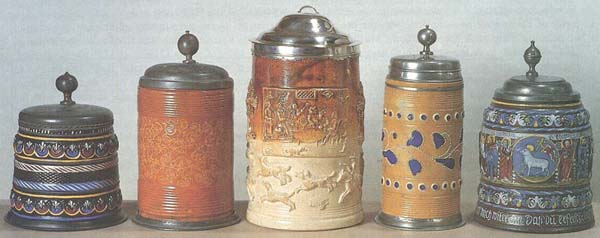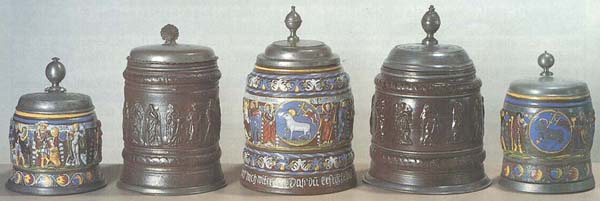
by Johannes Vogt
Translation and additions by Albert Nesmeth, M.D.
For ages, drinking, and raising one’s hand in a toast have played an important social role. It is therefore not surprising that steins have been produced for centuries in all imaginable shapes and materials that mirror the spirit of their time. For example, the drinking vessels of the Renaissance and Baroque periods are an expression of a luxurious life style and an unparalleled joy in drinking.
Most steins from the 17th and 18th centuries are products of the potter’s art. The type and composition of the clay found around the individual pottery centers determined whether Faience or stoneware was produced. The stoneware centers of the Rhineland and 90 Faience manufacturing centers founded in Germany between 1661 and 1750, achieved particular importance.
Faience Steins
The term “faience” refers to porous clay products that are coated with a special tin glaze to make them watertight. The clay was mostly taken from the vicinity of the manufacturer, and then mixed with lime and silicic acid. The prepared clay was then formed into steins by hand on the potter’s wheel with the aid of specially designed modeling woods. After the pieces were taken off the wheel, the handles were added and left to dry until they achieved a leatherhard consistency. They were then placed in the kiln for the first firing. After removal, the steins were dipped in a milky-white tin glaze, after which they were painted in so-called “high fired colors” by artists employed in the faience factory. This technique required a very sure and skilled hand because at this stage the artist was painting on a “wet” glaze that had not yet been fired. The paint was thus immediately soaked up by the glaze and the porous clay as if they were blotting paper — any changes or corrections in the painting were impossible!
 |
After the painting was completed, the stein was placed in the kiln again for the second firing at temperatures ranging from 900° - 1050° Celsius (1652° - 1922° Fahrenheit) so that the painting, glaze, and clay permanently fused with one another. Only a few colors, cobalt blue, yellow, manganese, green, iron-red and black, the so-called “high fired colors” (Scharffeuerarben), were able to withstand the high temperatures of this second firing, thus limiting the painter’s palette to these colors.
In contrast to this standard way in which the majority of faience steins were done was the possibility of painting them with the so-called “muffel colors” (Muffelfarben). Here the second high temperature firing took place as usual but without any painting. The artist thus had a smooth finished white glaze surface upon which to paint, similar to porcelain painting. The painting was fired on and fused to the glaze in a lower temperature, final third firing using a special muffel kiln. A “muffel” is a special clay capsule in which steins were placed to surround and protect them during the third firing. Muffel fired pieces, because they are done at lower temperatures, allowed a much broader and richer scale of colors to be used, including gold. Muffel painting always entailed painting on a smooth finished faience product which could be sent out to be painted by independent artists outside of the faience factory — the so-called Hausmalers.
 |
Since the founding of the first German faience factory in Hanau in 1661, faience steins were produced in factories in which everyone had individual roles in the production process. It was a time in which a mercantile economic system existed — a system that demanded that imports be limited — but exports multiplied by increasing the production of goods in one’s own land. This was the foundation upon which faience factories were built — as business enterprises protected by privileges granted by the rulers of any particular region. In short intervals, therefore, from the end of the 17th to the mid-18th century, faience factories were founded in a multitude of different principalities and small states in Germany, so that by the mid-18th Century approximately 90 factories produced faience in Germany.
The products of the faience factories were intended as a replacement for extremely expensive Chinese porcelain which, until about 1730, was being imported by the East India Company. The faience pieces thus served to provide the royal courts of Germany with dinnerware and room decorations. From 1680 to 1730 there was a craze for Chinese styles of decoration. Faience decorations resembling those on Chinese porcelain were all the rage during this period. By the middle of the 18th Century, the steins were decorated with German motifs and began to be bought by the middle classes. The princes and margraves preferred genuine porcelain, which by that time was being produced in Germany. At the end of the 18th century and the beginning of the 19th century, stoneware imported from England and the less expensive porcelain from Thuringia gave faience very stiff competition. Faience steins were then sold to the rural populace. The last faience factories closed in the mid-19th century, since their products could not compete in the prevailing market place.
Stoneware Steins
In contrast to the porous clay of faience, the clay of stoneware vessels, which was fired at temperatures of 1200° - 1300° Celsius (2192° - 2372° Fahrenheit), is vitrified, i.e., the stoneware clay is watertight, insensitive to most acids, and has become so hard that steel cannot scratch it. It is not necessary to seal stoneware with the addition of a glaze. To make stoneware less dull and lustreless in appearance, it was typically saltglazed, which gives stoneware its special sheen.
With the discovery of saltglazing by Cologne potters in the middle of the 15th Century, the Rhenish stoneware centers in Cologne, Frechen, Siegburg, Raeren, and the Westerwald began to flourish. Cologne and Frechen stoneware is characterized by a grey clay that was coated with iron-containing Engobe (a clay mixture into which stoneware was dipped, or which was either poured or brushed on it before it was fired to give it a glaze-like coating). This Engobe coating is the reason the vessels turned brown during firing, or received a brown, speckled surface. Bearded-Man jugs (Bartmanskruge) as well as the Pinte (a stein form with conical walls, shorter than a Schnelle) with applied relief decorations were the typical products of Cologne and Frechen.
 |
In the second half of the 16th century, Raeren developed into one of the most important pottery centers in the Rhineland because of the immigration of potters driven out of Cologne. Raeren stoneware, which is naturally dark grey, received its brown color through a saltglazed firing under oxygen-rich conditions. Characteristic products were steins and jugs decorated with applied reliefs of the seven electors or with scenes of the “farmer’s dance,” after H.S. Beham.
At the end of the 16th Century, stoneware production shifted to the clay-rich Westerwald region. Since that time, the grey-blue Westerwald stoneware steins, recognized worldwide, have been produced in the pottery centers of Höhr, Grenzau, and Grenzhausen. In the 16th and 17th centuries, the steins were decorated with applied reliefs and painted with cobalt-blue, and after 1650 they were also painted in manganese-violet. During the 18th Century, stamped, etched, and Knibis (zig-zag lines or fan-like ornamentation that is pressed into the stoneware with a piece of wood called Knibiswood) decorations gained in importance and replaced the applied relief decorations that had their origins in the Renaissance.
Parallel to the products of the Rhineland, important stoneware centers developed in Creussen, Saxony and Silesia. From the beginning of the 17th Century, in the upper Franconian city of Creussen, brown saltglazed stoneware was produced. The broad squat Humpen were decorated with applied reliefs and notch decoration. Some of them were painted with colorful enamels by the glass artists from the Fichtel mountain region. Very well-known, and loved by collectors, are the Creussen Apostle steins. The Planet, Hunting, and Elector steins from Creussen are more rare.
 |
In Saxony, stoneware was produced in the cities of Waldenburg, Altenburg, Annaberg, and Freiberg. Altenburg began producing stoneware in 1625. These were brown squat Humpen with notch decorations or applied prunts. During the course of the 17th Century white stoneware was produced in addition to brown. Among the most well-known Altenburg products are the cylindrical steins ornamented with pearl or applied relief decorations.
The Annaberg potters began producing a brown Engobe coated stoneware around 1630 and continued production into the 18th century. Typical products are squat Humpen and pear-shaped steins with a fish scale decoration and applied reliefs. Similar to Creussen stoneware, these are mostly painted with luminous enamels and gold.
__________
*Reprinted from The Beer Stein Journal, August 1994, by permission from Gary Kirsner Auctions.
Note: This is a translation from an article that originally appeared in the German Sammler Journal, September 1993.